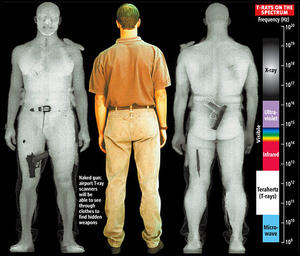NJIT physicist: Terahertz imaging is the ultimate defense against terrorism
THz imaging systems have an inherent advantage over millimeter wave imaging systems owing to the intrinsically improved spatial resolution that one can achieve with the shorter wavelength THz systems (typically 300 micrometer wavelength) compared to longer wavelength millimeter wave systems; instruments using terahertz imaging are widely used in laboratories and have shown some limited use in commercial applications — but a THz imaging system for security screening of people has not yet reached the market; the NJIT THz device has great promise

Terahertz scanner imagery // Source: dailymail.co.uk
John Federici, a physics professor at New Jersey’s Science and Technology University (NJIT), sees the use of terahertz rays as a critical technology in the defense against suicide bombers and other terrorist activities. Federici and his research team recently described experimental results from a digital video camera invented in their laboratory that uses a terahertz imaging system. One day such a device could be used to scan airport passengers quickly and efficiently.
In an article in Applied Optics the researchers report that they examined experimental results from a video-rate device. The device uses terahertz (THz) rays that emit a continuous narrow bandwidth radiation of 0.1 (THz). The instrument creates a two-dimensional image of a point in an object. The image is reconstructed at a rate of 16 milliseconds per frame with a four-element detector array. The number of detectors, the configuration of the detection array and how well the baselines are calibrated affects the image resolution and quality.
“Scientists favor terahertz radiation because it can transmit through most non-metallic and non-polar mediums,” said Federici. “When a terahertz system is used correctly, people can see through concealing barriers such as packaging, corrugated cardboard, walls, clothing, shoes, book bags, pill coatings, etc. in order to probe for concealed or falsified materials.”
Once the rays penetrate those materials, they can also characterize what might be hidden-be they explosives, chemical agents or more — based on a spectral fingerprint the rays will sense which can identify the material. terahertz radiation also poses minimal or no health risk to either the person being scanned or the THz system operator.
At this time, instruments using terahertz imaging are widely used in laboratories and have shown some limited use in commercial applications.
A THz imaging system for security screening of people has not yet reached the market. Researchers say that such a system is at least five years away. The NJIT device, though, has great promise. According to Federici, THz imaging systems have an inherent advantage over millimeter wave imaging systems due to the intrinsically improved spatial resolution that one can achieve with the shorter wavelength THz systems (typically 300 micrometer wavelength) compared to longer wavelength millimeter wave systems. Video-rate THz imaging systems, however, are not as well advanced as their millimeter wave counterparts.
One technical limitation in developing video-rate THz imaging is the cost of THz hardware components including detectors. Consequently, THz imaging systems create images using a very small number of detectors in contrast to the million or more detectors that are used in digital cameras.
According to Federici, one can use advanced imaging techniques, such as synthetic aperture imaging methods, to compensate for the relatively few number of THz detectors in an imaging system.
“The idea has been to apply different methods of imaging with radio waves, where many of the ideas for synthetic aperture imaging originated, to terahertz rays,” said Federici. His research team has focused in particular on applications of synthetic aperture imaging to the terahertz range. “The advantage of this particular method is the ability to generate terahertz images with a large number of pixels using a limited number of terahertz detectors. This imaging method should also be capable of video-rate imaging, thereby enabling the real-time monitoring of people hiding concealed explosives or other dangers.” A typical imaging system would be analogous to a still or video camera designed for this purpose.
In 2005 Federici and his research team received a U.S. patent for a terahertz imaging system and method that enables video-rate THz imaging with a limited number of detectors. Since 1995 terahertz imaging has grown in importance as new and sophisticated devices and equipment have empowered scientists to understand its potential. DHS, the U.S. Army Research Office, Department of Defense, and the National Science Foundation support Federici’s work.
While researchers have focused on the potential applications of terahertz rays for directly detecting and imaging concealed weapons and explosives, they say another application is the remote detection of chemical and biological agents in the atmosphere.
—Read more in Zhiwei Liu et al., “Video-rate Terahertz Interferometric and Synthetic Aperture Imaging, Applied Optics 48, no. 19 (1 July 2009): 3788-95 (sub. req.)
